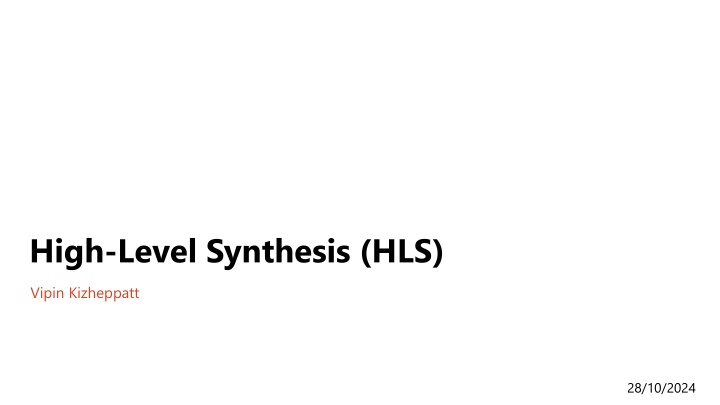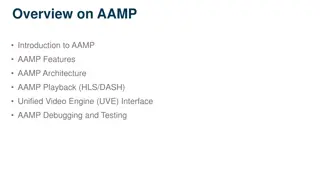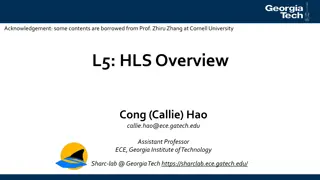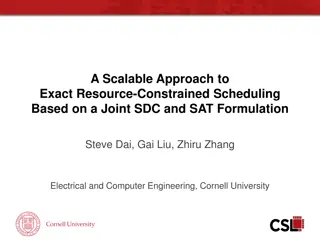
High-Level Synthesis (HLS) for Efficient Hardware Design
Explore the evolution of hardware design from manual transistor specifications to automated tools like RTL and High-Level Synthesis (HLS) for abstracting architectural complexities. HLS tools automatically optimize RTL designs, balance resource usage, and achieve efficient implementation, making it a valuable technique in modern hardware design.
Download Presentation

Please find below an Image/Link to download the presentation.
The content on the website is provided AS IS for your information and personal use only. It may not be sold, licensed, or shared on other websites without obtaining consent from the author. If you encounter any issues during the download, it is possible that the publisher has removed the file from their server.
You are allowed to download the files provided on this website for personal or commercial use, subject to the condition that they are used lawfully. All files are the property of their respective owners.
The content on the website is provided AS IS for your information and personal use only. It may not be sold, licensed, or shared on other websites without obtaining consent from the author.
E N D
Presentation Transcript
High-Level Synthesis (HLS) Vipin Kizheppatt 28/10/2024
Introduction When the circuits were small, hardware designers could specify every transistor, and everything was done manually As our ability to manufacture more transistors increased, hardware designers began to rely on automated design tools These tools gradually become more and more sophisticated and allowed hardware designers to work at higher levels of abstraction Register-transfer level (RTL) was one step in abstraction 2
Introduction 3 Hand drawn schematic (by Federico Faggin) of the ALU of the first micro processor (4004)
RTL EDA tools can translate RTL specifications into a digital circuit model and then subsequently into the detailed specification High-level synthesis (HLS) is yet another step in abstraction that enables a designer to focus on larger architectural questions rather than individual registers and cycle-to-cycle operations An HLS tool creates the detailed RTL micro-architecture from a high-level language Most of the commercial tools now use C/C++ as the input language 4
HLS Algorithmic HLS does several things automatically that an RTL designer does manually analyzes and exploits the concurrency in an algorithm inserts registers as necessary to limit critical paths and achieve a desired clock frequency implements interfaces to connect to the rest of the system Maps data onto storage elements to balance resource usage and bandwidth Maps computation onto logic elements performing user specified and automatic optimizations to achieve the most efficient implementation 5
Vitis HLS The goal of HLS is to make these decisions automatically based upon user-provided input specification and design constraints The designer is expected to supply the HLS tool a functional specification, describe the computational device, and give optimization directives Vitis HLS requires the following A function specified in C, C++, or SystemC A design testbench that calls the function and verifies its correctness by checking the results A target FPGA device The desired clock period Directives guiding the implementation process interface, provide a target 6
HLS HLS tools cannot handle arbitrary software code For example usually they cannot implement dynamic memory allocation Limited support for standard libraries System calls are usually avoided Ability to perform recursion is often limited They typically requires additional information provided by designers (#pragmas) 7
HLS HLS tools cannot handle arbitrary software code For example usually they cannot implement dynamic memory allocation Limited support for standard libraries System calls are usually avoided Ability to perform recursion is often limited They typically requires additional information provided by designers (#pragmas) Other hand HLS tools can Deal with variety of interfaces (DMA, streaming, on-chip memory) optimization) Perform advanced optimizations (pipelining, memory partitioning, bitwidth 8
HLS The primary output of HLS is an RTL that is capable of being synthesized through the rest of the hardware design flow The tool will provide some estimates on resource usage and performance Vitis HLS generates the following outputs Synthesizable Verilog and VHDL RTL simulations based on the design testbench Static analysis of performance and resource usage Using Vivado Design suite then this RTL can be implemented on the target FPGA 9
Performance Characterization We use the term task to denote a function invocation in Vitis HLS Task latency is the time between when a task starts and when it finishes Task interval is the time between when one task starts and the next starts or or the difference between the start times of two consecutive tasks 10
ap_ctrl_hs Interface Signal ap_rst ap_idle ap_start Active high reset A high-value indicates the IP is idle. This signal should be asserted for the IP to start operation. It should be kept asserted until ap_ready is asserted Once ap_ready goes High: If ap_start remains High the design will start the next transaction If ap_start is taken Low, the design will complete the current transaction and halt operation Indicates that the IP has received all the data for the required operation ap_ready ap_done ap_return Asserted when the IP completes the operation If ap_return is present, ap_done high indicates the value on the bus is valid 12
Performance Calculations In terms of X bits/second Y operations/second MAC operations/sec Performance requirement is specified in terms of the target clock frequency (and task interval) Increasing target clock frequency is not necessarily optimal in terms of overall system Lower frequencies enable operation chaining This may allow higher performance by improved logic synthesis optimizations and reducing the resource utilization For zynq 7000 platform, a good starting point for clock frequency will be 100 MHz 14
Operation Chaining Multiply operation requires 3ns and addition requires 2 ns Then the effect of clock period constraint on throughput (200 Million MAC/sec) (167 Million MAC/sec) (200 Million MAC/sec) 15
FIR Filter Design N 1b[k].x[n k] y[n] = k=0 16
FIR C Code 17
Code hoisting If/else statement inside a loop is quite inefficient For every control statement, HLS generates corresponding hardware logic which executes in each loop iteration If statement checks when x == 0, which happens only on the last iteration Therefore, statements within the if branch can be hoisted out of the loop. 18
Code Hoisting Loop bound is changed Moved out of the loop 19
Loop Fission Loop fission takes different operations and implements each of them in their own loop This enables to apply optimizations independently to the loops Does not guarantee performance improvement (it may even make performance worse) 20
Loop Fission 21
Loop Unrolling By default, Vitis HLS synthesizes loops in a sequential manner Data path is implemented to execute the logic inside the loop once and is repeated with the help of a control logic (FSM) This is highly area efficient but doesn t explore the parallelism Loop unrolling replicates the body of the loop by some number of times called factor It reduces the number of iterations of the loop by the same factor Loop unrolling can increase the overall performance provided some (or all) of the statements can be executed in parallel 22
Loop Pipelining Loop pipelining is an optimization that overlaps multiple iterations of a for loop Loop initiation interval (II) is an important performance metric here It is defined as the number of clock cycles until the next iteration of the loop can start If loop II is 1, which means that we start a new iteration of the loop every cycle This may not always be possible due to resource constraints and/or dependencies in the code 24
Bitwidth Optimization C language provides many different data types to describe different kinds of behavior but all of them have a size which is power of 2 In many cases to implement optimized hardware, it is necessary to process data where the bitwidth is not a power of two Vitis HLS provides arbitrary precision data types which allow for signed and unsigned data types of any bitwidth Unsigned: ap_uint<width> Signed: ap_int<width> the width variable is an integer between 1 and 1024 26
Bitwidth Optimization To use these data types your source code should be in C++ (with .cpp extension) need to include the header file ap_int.h #include "ap_int.h ap_int<5> add(ap_int<5> a, ap_int<5> b){ return a+b; } 27
Thank you any questions 28





